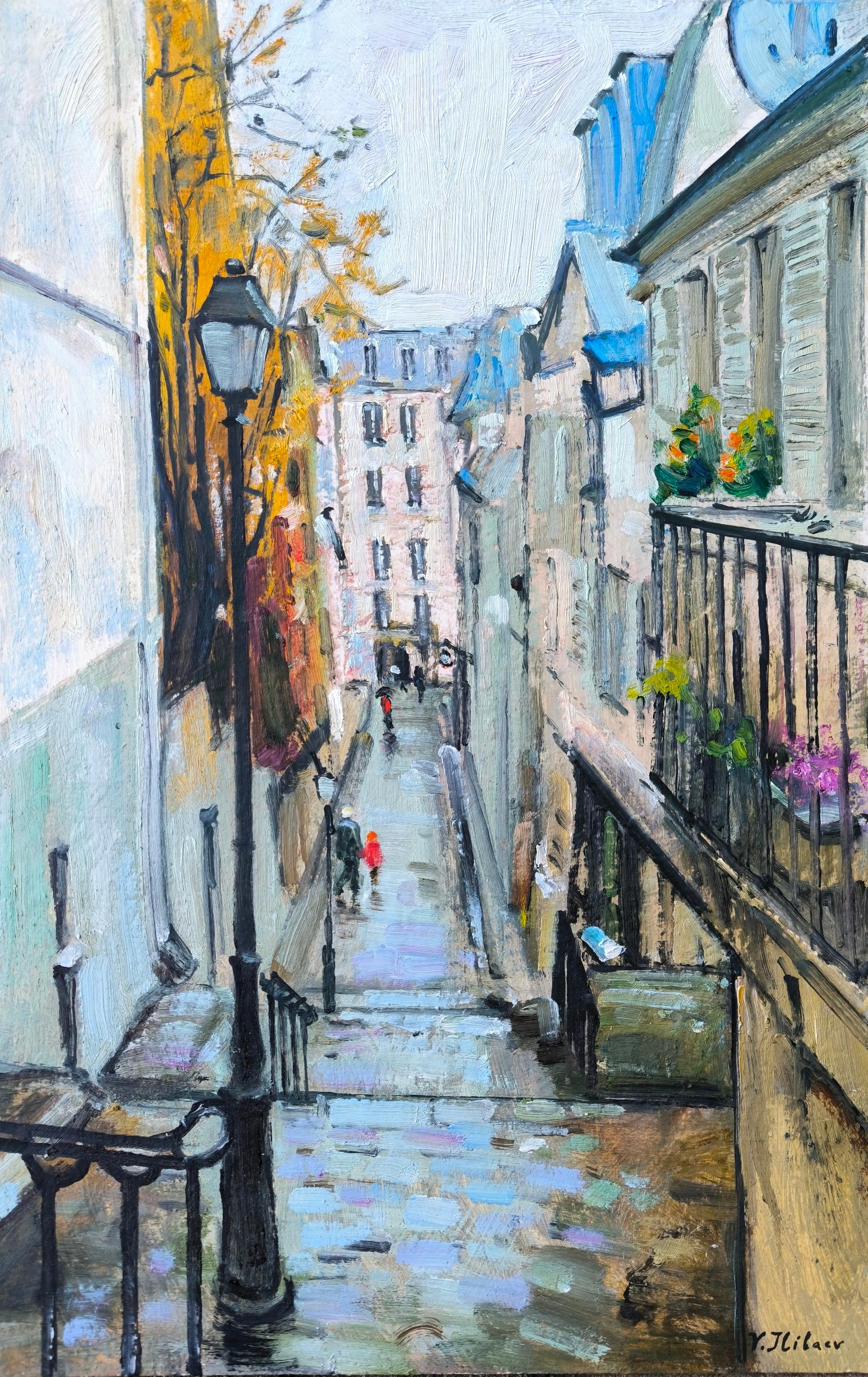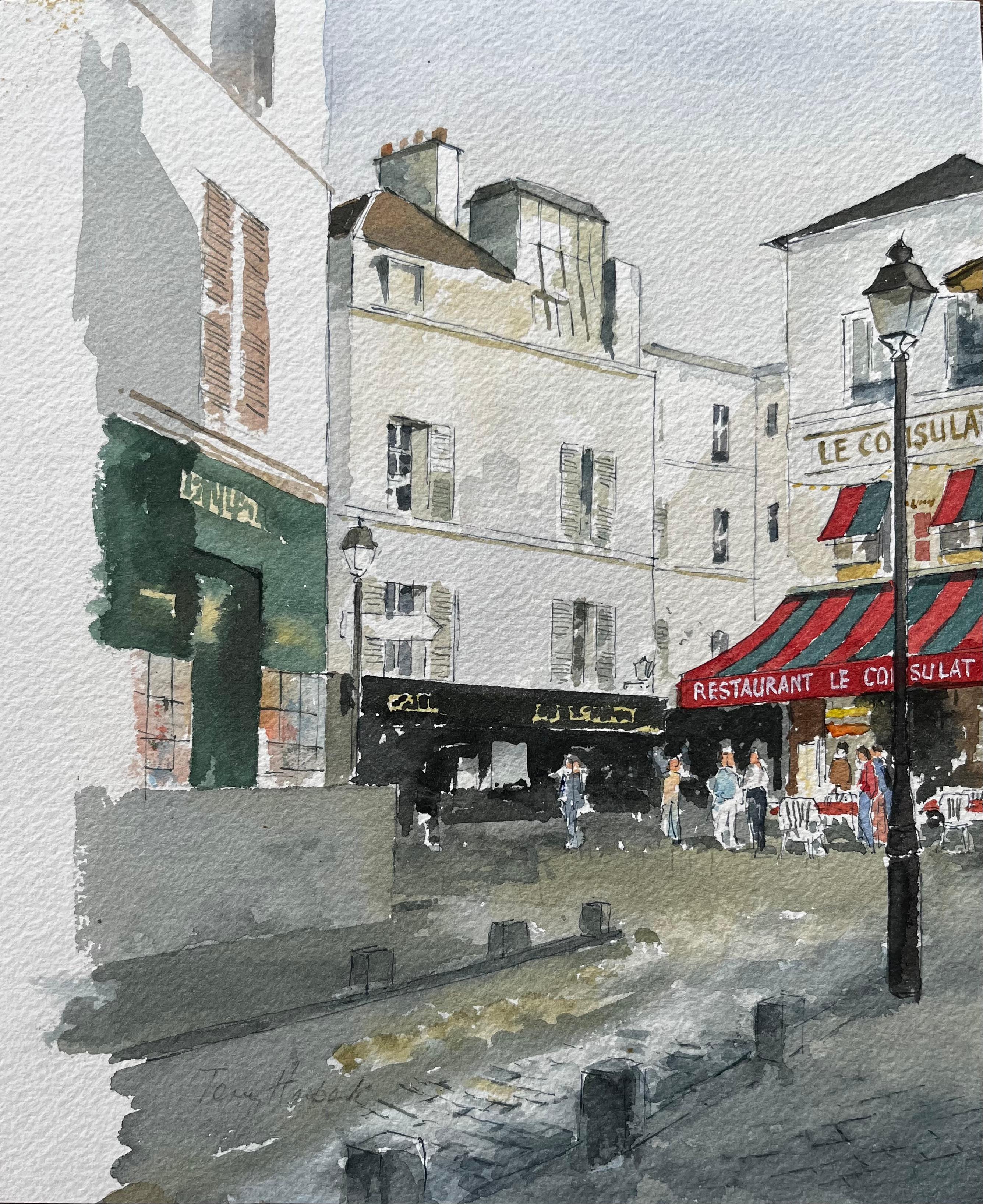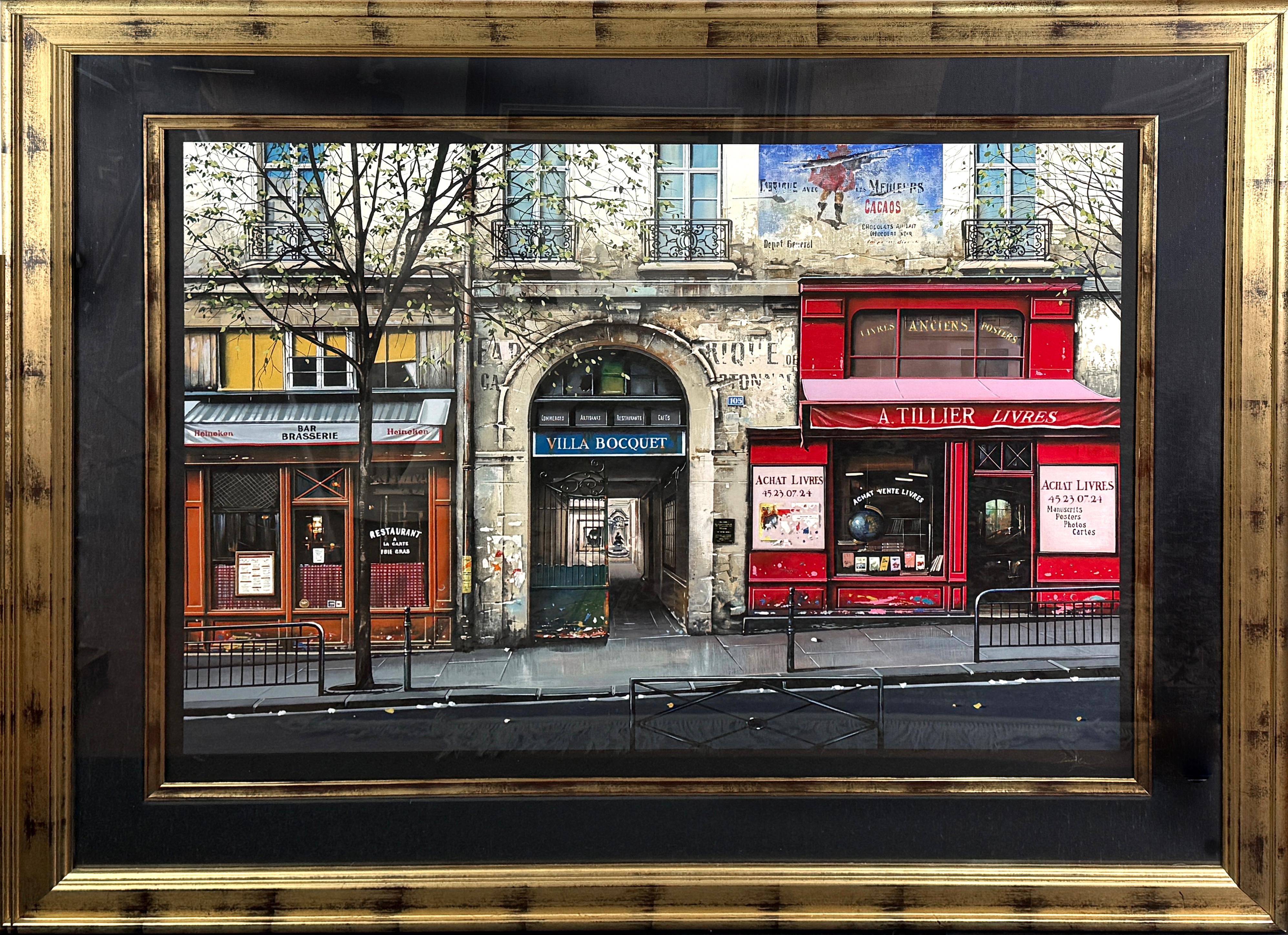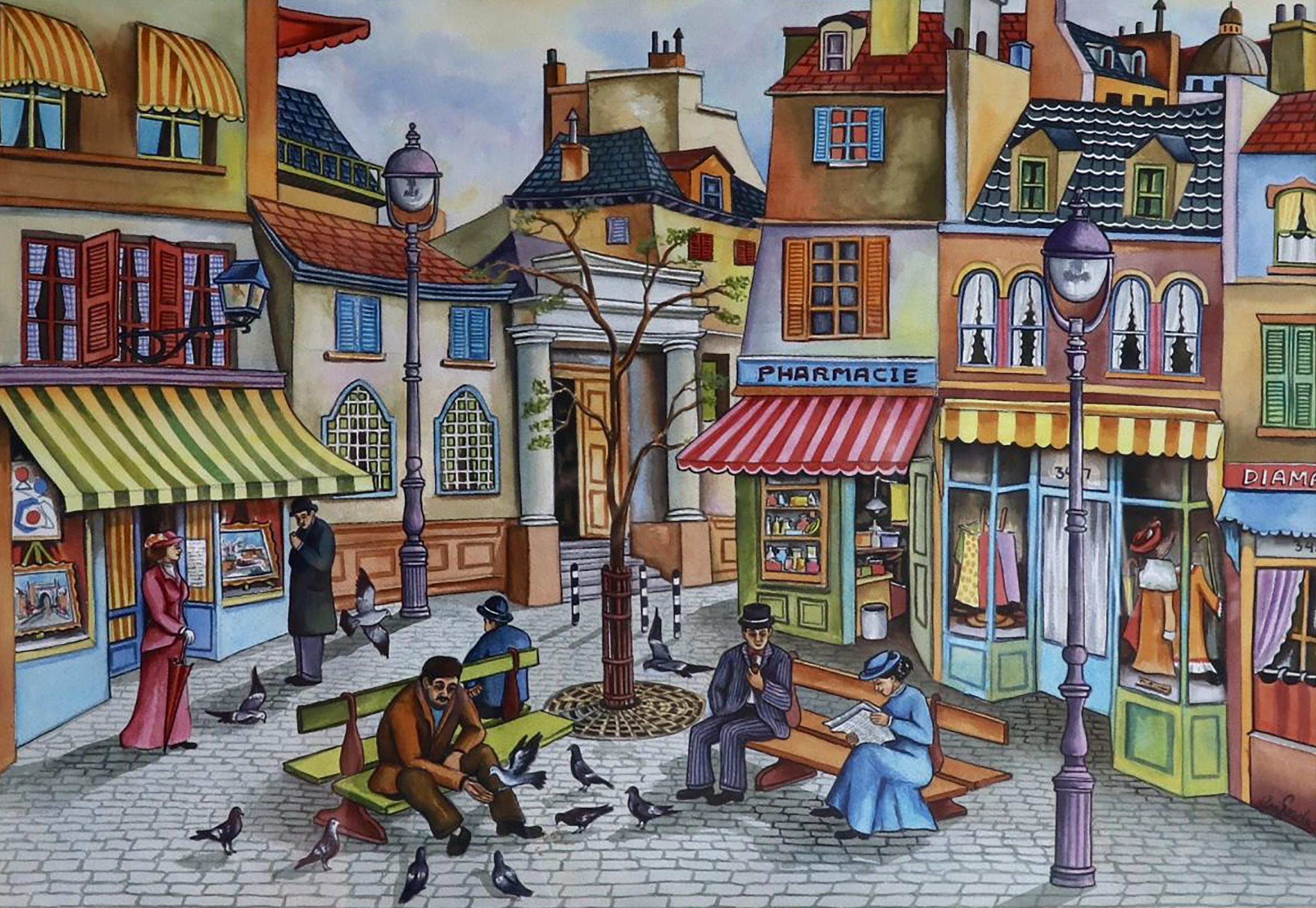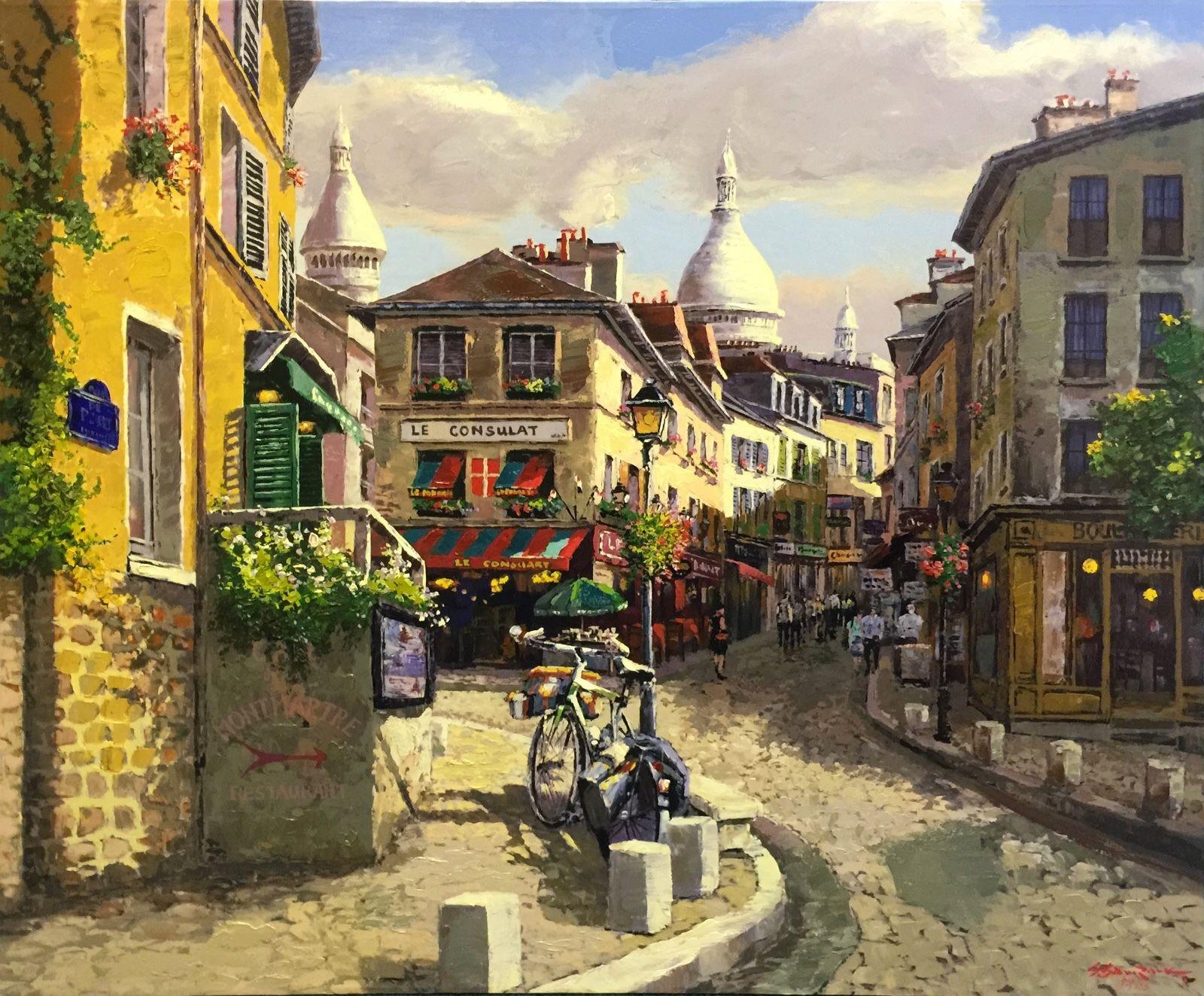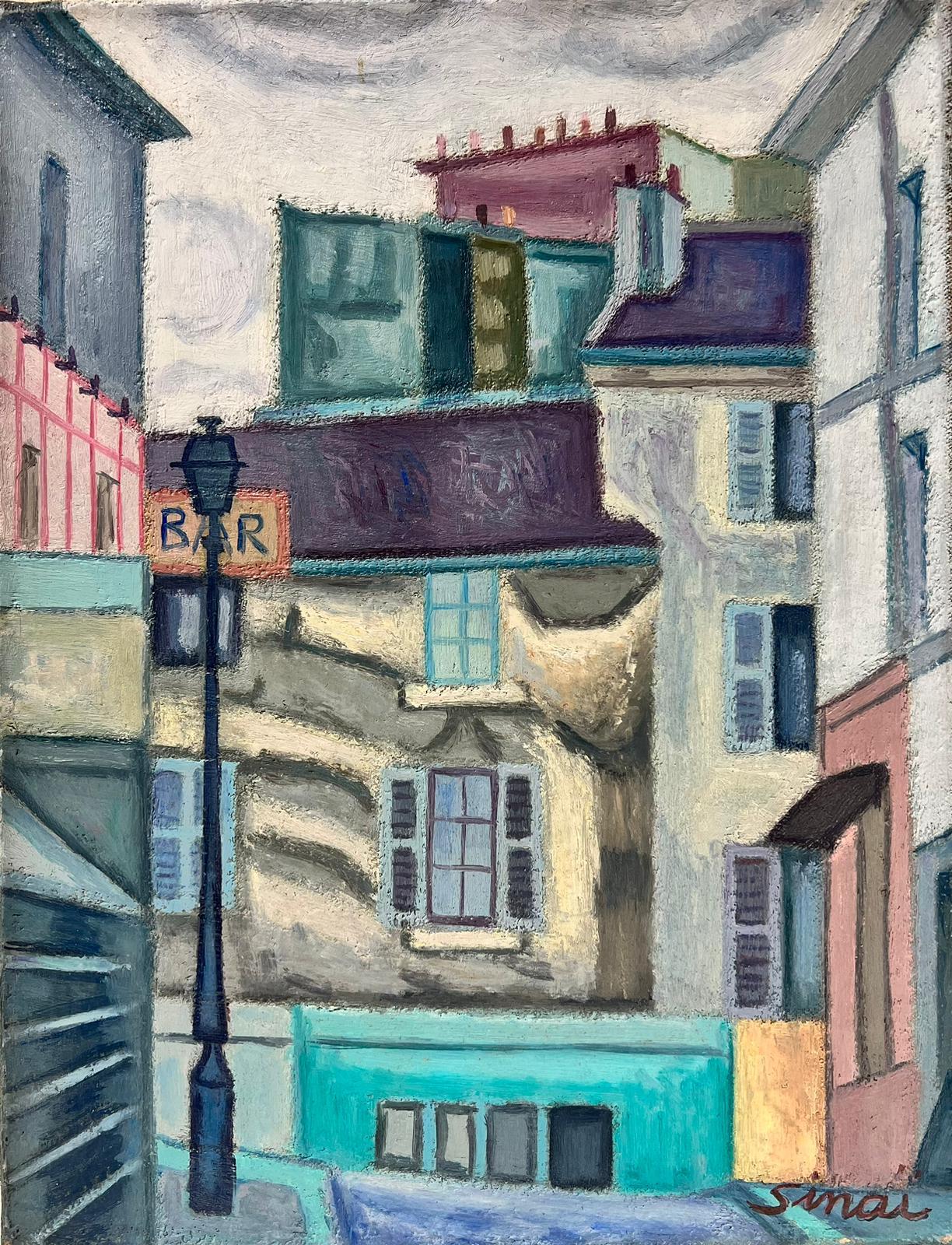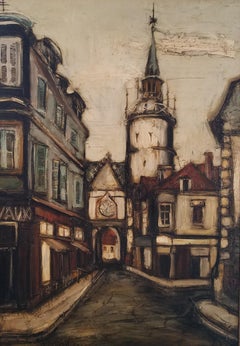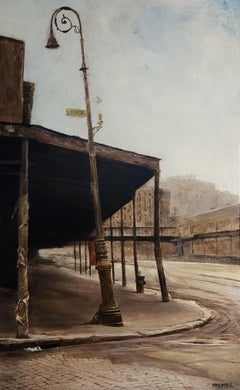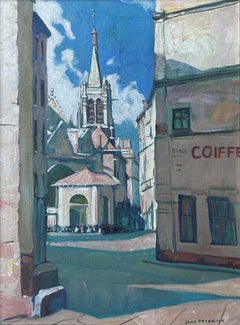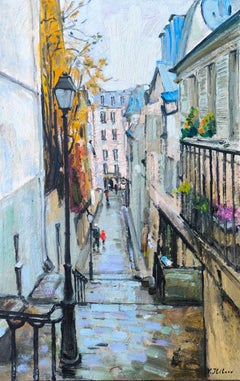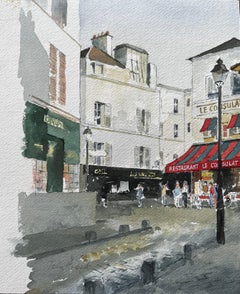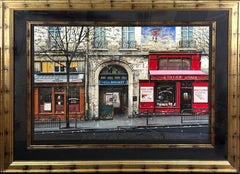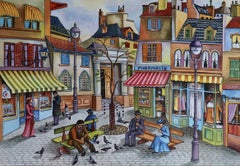Items Similar to "Montmartre Street Scene, Paris, France" Thomas Pradzynski, Architecture
Want more images or videos?
Request additional images or videos from the seller
1 of 7
Thomas Pradzynski"Montmartre Street Scene, Paris, France" Thomas Pradzynski, Architecture
$9,600
$12,00020% Off
£7,337.26
£9,171.5820% Off
€8,456.78
€10,570.9820% Off
CA$13,749.05
CA$17,186.3120% Off
A$15,068.54
A$18,835.6720% Off
CHF 7,869.08
CHF 9,836.3520% Off
MX$180,805.05
MX$226,006.3120% Off
NOK 98,809.69
NOK 123,512.1120% Off
SEK 93,075.07
SEK 116,343.8320% Off
DKK 63,150.57
DKK 78,938.2120% Off
About the Item
Thomas Pradzynski (1951 - 2007)
Montmartre Street Scene, Paris, France
Oil on canvas
16 x 32 inches
Signed lower right
At the age of 26 Thomas Pradzynski left his native Poland for Paris with the aspiration of becoming an artist. The year was 1977. Knowledge of architecture and a love of art were his main interests. His ideal was to "romanticize the empty streets and the traces of the past and to preserve places that are slowly disappearing." The path he laid before him was paved with warmly lit Parisian streets, dark windows and open doorways. The art he was about to create would not only echo his surroundings but also communicate his passion for their preservation.
The artist was born in Lodz, Poland, on November 29, 1951. His childhood was greatly influenced by his aunt Joanna, an artist in Krakow. Joanna recognized his talent and soon became his tutor. When he was nine, his family moved to the Montmartre district of Paris, where the city galvanized his creative spirit. The excitement of the modern city was like no other he had experienced. He was enamored by the freedom expressed by its inhabitants, most importantly, by the street painters with their brightly colored canvases. Upon returning to Poland in 1965, he resumed his artistic studies in painting and drawing.
Bowing to family demands that he pursues a more practical course in life, Thomas eventually took degrees in Sociology and Economics. In 1977 he exiled to Paris with his wife Joanna. Paris continues to inspire Pradzynski through its urban charm. The labyrinthine streets of Montmartre and the Latin Quarter have become his outdoor studios. Pradzynski's work explores and the streets of Paris like a solitary lover whom every window, doorway and cafe is filled with meaning. Much of Pradzynski's mood is created upon the stage of old Parisian buildings and storefronts. The actors become a window, two chairs, or a doorway whose interplay with light and shadow perform for the audience of our memories and dreams.
Throughout the 19th century and for half of the twentieth, Paris served as a beacon for artistic expression, drawing artists from all over Europe and the United States. Writers, painters, musicians and poets have all been inexorably drawn to this creative mecca. To name a few: Delacroix, Renoir, Toulouse-Lautrec, Picasso, Van Gogh, Edward Hopper, Camus, Sartre and Hemingway. Within the confines of smoky cafes, Pradzynski found the creative atmosphere conductive to his own inspirations. Much like his contemporaries, Pradzynski's inspirations turned into though provoking creations.
The street scenes portrayed in Pradzynski's paintings appear to be within the category of "realism." The term "realism," however, is as varied as the individual. The Realist artists discover that their external reality is inescapable from their own subjectivity. The depiction of a scene is primarily interpreted by the artist and secondarily interpreted by the viewer. Through this dual interpretation the artist is able to achieve a shared experience from an otherwise personal environment. As a realist, Pradzynski focuses his composition on the amount of content he can add to the subject matter. In order to reveal more than one would ordinarily see with the naked eye, Pradzynski utilizes his talents of "photo realism." The canvas ultimately contains more subject matter than the eye would normally perceive, therefore taking the perspective of a camera. Details in the painting provide the viewer with a sense of intimacy by bringing the subject within the range of public scrutiny.
The Realist painters of the 19th century were initiated in France by Gustave Courbet, who believed that "painting is an essentially concrete art, and can consist only of the representation of things both real and existing." Although Pradzynski maintains close tradition with Courbet in style, in theme he is more closely related to Edouard Manet. Manet believed that realism in technique could be mixed with myth in subject matter. Pradzynski's painted buildings are not entirely true to their Parisian location and in their assemblage become fictional. Manet's definition of Realism would still include Pradzynski's fictitious arrangement of subject matter since his style remains true to life. This theme of "fictitious Realism" found its way to the 20th century and onto the canvases of contemporary artists. What makes Pradzynski's work distinct, is the psychological introspection that elevates it from mere reportage to poetry. Although one is tempted to react first to the work with a sense of nostalgia, one quickly realizes that this is not the emotional key with which to unlock meaning and beauty.
In both mood and method Pradzynski bears close relation to the great American artist Edward Hopper. Where Hopper's painting embrace unique interplay of light to isolate his subject, Pradzynski's light is softer and the subjects are more intimate. With Hopper, the viewer in an intruder on the scene, an uneasy voyeur of uncomfortable truths, while
Pradzynski allows the viewer to participate in the scene. Similar to the mood of Padzynski's street scenes. Hopper's still cross sections of the city life portray a mood suspended in time. Both artists use similar forms of Realism to record a memory of relevance in their own lives. The similarity of content in their street scene is notable: vacant streets, open windows, and the warmly lit presence of inhabitants within decorated storefronts. In Pradzynski's paintings, Paris is viewed in perspectives that are devoid of people. This requires one to place himself at he scene and to explore an inner reaction; a technique also used by Hopper. The space created between the viewer and the scene in Pradzynski's paintings allows a pedestrian perspective to develop. Although their portrayals are of separate cities, the Realistic method complimented by a somber mood are threads common in both the paintings of Thomas Pradzynski and Edward Hopper. Pradzynski's use of light is comparable to Realist Richard Chiriani, who describes his subject matter's form through light and shadow. Not unlike Chiriani's paintings of aquatic life, Pradzynski's wandering shadows compliment his details with abstract shapes and take the viewer's imagination inside the quiet buildings where life takes form. As seen in the work of both artists, light is applied with a sensitivity that renders a subdued ambiance while embracing elements of expectation.
Feelings of anticipation are stirred upon viewing the white chair in "Le Cafe," and the bicycle in "Une Bicyclette a Florence." In a seemingly static environment these objects take on a life of their own; catalysts capable of initiating action at any moment, provoking the feeling that someone may occupy the chair or ride the bicycle away. Metaphorically, they act as a human presence, an abstraction of Pradzynski's own persona. Often Pradzynski paints more than one central scene, allowing the viewer an opportunity to view not only the immediate urban environment, but also to venture into the more intimate vignettes within the work. By carefully controlling his use of vanishing perspectives, Pradzynski creates a rhythmic transition between the multiple scenes. In "Le Cafe," a dark and intimate passage lures the viewer to explore both the private inner garden of sunlit trees and the colorful frontal shops. They are surveyed with equal interest and curiosity. The realistic detail used in Pradzynski's paintings reveals vulnerability on the buildings' surface while their solidity of design reassures us of their permanence. The buildings encompass their own dignity as well as reflecting a humble endurance toward time. Abstract shapes formed upon the building's stone surface in "Une Bicyclette a Florence" create the layered appearance of antiquity, a style comparable to that of earlier realists like Maurice Utrillo.
Pradzynski's architectural forms, while remaining classic in design, create mysterious shadows as well as secret passageways. The effect of light is naturalistic as well as allegorical. The shadows give the natural feel of depth and contour, while they romantically embrace each building as if to preserve its most intimate details. Pradzynski's light further acts to convey the meaning of continuous time and can best be analyzed in "Twilight on Rue de Madrian." Light coming from different angles reflecting upon the damp streets and weathered facades creates alternate perspectives. Thus, light seems to have more of a symbolic connotation rather than a naturalistic presence. The artist has created a prismatic collage of time itself.
Nostalgia informs much of Pradzynski's work. It is a feeling he searches out in the deserted streets, a mood he discovers in an image reflected off a window or in a building's crumbling facade. Whether it is empty street, the riderless bicycle propped against a wall, an unattended table in a small cafe, his images reveal the impulse in us
all to hold tight to traces of the past, while the occasional open doorway lends the imagery mystery and suggests a future, inevitable yet unknown.
No simple interpretation of Thomas' work is either fitting or rewarding. His great popularity is due, at least in part, to the accessibility of his imagery. Pradzynski's work is readable yet psychologically and emotionally complex.
Thomas Pradzynski has successfully laid claim to a re-imagined Paris, one completely his own. Its streets are empty but the complex experience of human emotion has not deserted them. His city is a unique configuration of dream and remembrance; mystery and anticipation. He has transformed the alleyways, cafes and open doorways into metaphor.
Pradzynski's Paris is nothing less than a hauntingly evocative street map of our own emotions.
- Creator:
- Dimensions:Height: 20 in (50.8 cm)Width: 36 in (91.44 cm)
- Medium:
- Movement & Style:
- Period:
- Condition:
- Gallery Location:New York, NY
- Reference Number:1stDibs: LU184129919912
About the Seller
5.0
Platinum Seller
Premium sellers with a 4.7+ rating and 24-hour response times
Established in 2022
1stDibs seller since 2022
126 sales on 1stDibs
Typical response time: <1 hour
- ShippingRetrieving quote...Shipping from: New York, NY
- Return Policy
Authenticity Guarantee
In the unlikely event there’s an issue with an item’s authenticity, contact us within 1 year for a full refund. DetailsMoney-Back Guarantee
If your item is not as described, is damaged in transit, or does not arrive, contact us within 7 days for a full refund. Details24-Hour Cancellation
You have a 24-hour grace period in which to reconsider your purchase, with no questions asked.Vetted Professional Sellers
Our world-class sellers must adhere to strict standards for service and quality, maintaining the integrity of our listings.Price-Match Guarantee
If you find that a seller listed the same item for a lower price elsewhere, we’ll match it.Trusted Global Delivery
Our best-in-class carrier network provides specialized shipping options worldwide, including custom delivery.More From This Seller
View All"Cityscape in France, " Franz Priking, Large Vertical Modern French Town Scene
Located in New York, NY
Franz Priking (1927 - 1979)
Cityscape in France, n.d.
Oil on canvas
46 x 32 inches
Signed and dated lower left
Provenance:
Private Collection, New York
...
Category
1950s Modern Landscape Paintings
Materials
Canvas, Oil
$10,000 Sale Price
20% Off
"10th Avenue, Meatpacking District" Harry McCormick, New York City Urban Scene
By Harry McCormick
Located in New York, NY
Harry McCormick
10th Avenue, Meatpacking District, New York
Signed lower right
Oil on masonite
23 7/8 x 15 inches
Renowned for his exquisite depiction of light and shadow, Harry Mc...
Category
1970s Contemporary Landscape Paintings
Materials
Masonite, Oil
"Street In Paris (Eglise St. Julien)" Jane Peterson, American Impressionism
By Jane Peterson
Located in New York, NY
Jane Peterson
Street In Paris (Eglise St. Julien), circa 1910
Signed lower right; artist's labels on the reverse
Oil on canvas
24 x 18 inches
Exhibited
New York, Lincoln Glenn Galle...
Category
1910s American Impressionist Figurative Paintings
Materials
Canvas, Oil
"Empire State Building" Leon Dolice, New York City Street Scene, Mid-Century
By Leon Dolice
Located in New York, NY
Leon Dolice
Empire State Building
Signed lower right
Watercolor on paper
19 x 12 inches
The romantic backdrop of Vienna at the turn of the century had a life-long influence upon th...
Category
1930s American Modern Figurative Drawings and Watercolors
Materials
Paper, Pastel
"Place Jeanne D'Arc, Paris, " Jules Herve, French Impressionism, Cityscape Street
By Jules René Hervé
Located in New York, NY
Jules Herve (French, 1887 - 1981)
Place Jeanne D'Arc, Paris, circa 1930
Oil on canvas
8 3/4 x 10 3/4 inches
Signed lower right; signed on the reverse
Jules Rene Herve, an impression...
Category
1930s Impressionist Landscape Paintings
Materials
Canvas, Oil
"Venice Canal, Italy" Claude Venard, French Post-Cubist Mid-Century Modern
By Claude Venard
Located in New York, NY
Claude Venard (French, 1913 - 1999)
Venice Canal, Italy, circa 1950-55
Oil on canvas
24 x 24 inches
Signed lower center
Provenance:
Private Collection, Massachusetts
The authenticity of this work has been confirmed by Galerie Felix Vercel.
Claude Venard was a notable exponent of the French mid-century post-Cubist movement. He was born to bourgeois parents from Burgogne in Paris, on March 21, 1913. At the age of 17, he enrolled and attended the Ecole des Beaux-Arts, but remained for only two days, not adhering to the school's academic style. Instead, he spent the following six years at the École des Arts Appliqués, taking evening classes and embracing the contemporary Parisian art scene, all the while becoming recognized in its circles.
Not able to support himself as an artist, by 1936 he found employment as a restorer at the Louvre, further honing his artistic skills.
Paris of the period was dominated by an art trend that strongly favored abstraction. Following a group show at the Galerie Billet-Worms in 1935, art critic Waldemar George declared: "Let's be young again! Painting is not dead… Its course has not stopped. Forces Nouvelles is born."
Venard contributed and initially adhered to the strict disciplines of the Forces Nouvelle group. But as with many of his fellow members, he soon abandoned it seeking individual expression.
Following WWII, Venard rekindled friendships with past Forces Nouvelles members, joining Pierre Tal-Coat, André Marchand, André Civet...
Category
1950s Cubist Landscape Paintings
Materials
Canvas, Oil
You May Also Like
Street in Montmartre
Located in Riga, LV
Vladimir Ilibayev(1952). Painter
Born in Ventspils, Latvia in 1952.
Education
Studied 2 years in Moscow State University, the Faculty of Philosophy.
Graduated from St. Peterburg ...
Category
2010s Realist Landscape Paintings
Materials
Oil, Cardboard
$1,707 Sale Price
40% Off
Paris Street Scene With Le Consulat Café And Classic Montmartre Architecture
Located in Cirencester, Gloucestershire
Title: Paris Street Scene With Le Consulat Café And Classic Montmartre Architecture
By Tony Herbert (1927-2024)
Signed: Bottom left corner
Medium: Watercolor on paper, unframed
Size:...
Category
20th Century Impressionist Landscape Paintings
Materials
Watercolor
Villa Bocquet Paris Street and Cafe Scene by Thomas Pradzynski
By Thomas Pradzynski
Located in Soquel, CA
Thomas Pradzynski
1951–2007
Internationally renowned Modern Realist, Thomas Pradzynski painted street scenes of cities throughout the world, but was inspired and captured the mood, t...
Category
Early 2000s French School Landscape Prints
Materials
Screen
Paris Street Scene
By Ari Gradus
Located in Fort Washington, PA
Medium: Oil on Board
Signature: Signed Lower Right
Category
20th Century Landscape Paintings
Materials
Oil, Board
MONTMARTRE (HAND EMBELLISHED)
By Sam Park
Located in Aventura, FL
Deluxe hand embellished enhanced canvas. Hand signed and numbered on front by the artist. Stretched. Artwork is in excellent condition. Certificate o...
Category
Late 20th Century Impressionist Landscape Prints
Materials
Canvas, Giclée
$1,680 Sale Price
30% Off
Back Streets of Paris Signed French Modernist Oil Painting 20th Century
Located in Cirencester, Gloucestershire
French School, late 20th century
signed
oil painting on canvas, unframed
canvas: 14 x 10.5 inches
provenance: private collection, France
condition: very good and sound condition
Category
Late 20th Century Modern Landscape Paintings
Materials
Canvas, Oil
$381 Sale Price
20% Off
More Ways To Browse
Window Chair
Courbet Paintings
Thomas Pradzynski
Hillier Parker
Holland Painting Of Boats
Hunting Scene Horse Hound
Idaho Landscape Painting
Impasto Painting Boat
Ireland Sketch
Irwin Whitaker
James Reynolds
Josep Maria Vayreda Canadell On Sale
Joshua Tree Painting
Jules Noel
Kansas Oil Painting
Kit Carson
La Montagne Painting
Landscape Painting By Collins
